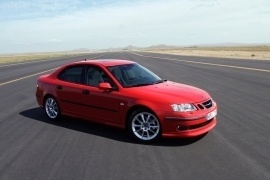Saab was under the GM umbrella when it introduced the second generation of the 9-3 range as a compact sedan with a sporty and premium character.
General Motors desperately tried to make the Swedish brand profitable because they were bleeding money. For that, they granted them the platform from a Vauxhall/Opel Vectra and Cadillac BLS, telling them to build a car on top of that, but with minimal changes. Saab considered that the platform was too weak to meet its safety standards. In the end, the 9-3 shared only 30% of the parts with other GM vehicles.
From the outside, there was a specific design. Saab shared didn’t share any body panel with its siblings. Its headlights sported an angular design with a Saab-specific grille between them. Also, the wrapped-around bumper featured an apron extended forward. In a collision with a pedestrian, that design lifts the person above the car, not underneath. Later on, that measure was implemented and mandatory on most European vehicles, but Saab did it in 2002.
Inside, Saab didn’t take any switch or button from the GM parts bin. Not even the infotainment unit. Saab did a better job for that, but more expensive. Its key-fob mounted between the front seats was a signature feature for the Swedish brand. The center stack formed together with the instrument panel a surrounding area for the driver. For the Aero trim level, the sport bucket-seats with high bolstering were standard.
Under the hood, Saab installed a unique turbocharged 2.8-liter engine. Later on, Opel/Vauxhall carried that over on the Insignia OPC/VXR. But when Saab introduced it, it was too expensive for the market. It sent its power to the front wheels via a six-speed gearbox, either manual or automatic.

























































